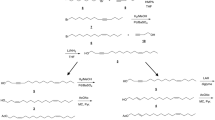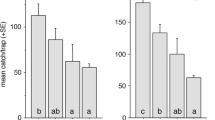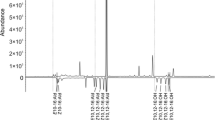Abstract
E∶Z blends of (E)-11-tetradecenal were field tested (three experiments) for their attractiveness to male spruce budworm,Choristoneura fumiferana (Clemens), moths in northern Maine. Blends of 92.5–99%E isomer caught the most moths (three experiments); blend 95%E had the highest cumulative catch throughout two experiments. Rates of catch per hour for the four most attractive blends (92.5–99%E) showed highly variable responses among experiments; however, similarities were noted for rates of catch within the same experiment. For all experiments and observation hours, blend 95%E had the highest mean rate of catch.
Similar content being viewed by others
References
Cory, H.T., Daterman, G.E., Daves, Jr., G.D., Sower, L.L., Shepherd, R.F., andSanders, C.J. 1982. Chemistry and field evaluation of the sex pheromone of western spruce budworm,Choristoneura occidentalis, Freeman.J. Chem. Ecol. 8:339–350.
Houseweart, M.W., Jennings, D.T., andSanders, C.J. 1981. Variables associated with pheromone traps for monitoring spruce budworm populations (Lepidoptera: Tortricidae).Can. Entomol. 113:527–537.
Ramaswamy, S.B., andCardé, R.T. 1982. Nonsaturating traps and long-life attractant lures for monitoring spruce budworm males.J. Econ. Entomol. 75:126–129.
Sanders, C.J. 1978. Evaluation of sex attractant traps for monitoring spruce budworm populations (Lepidoptera: Tortricidae).Can. Entomol. 110:43–50.
Sanders, C.J. 1981a. Release rates and attraction of PVC lures containing synthetic sex attractant of the spruce budworm,Choristoneura fumiferana (Lepidoptera: Tortricidae).Can. Entomol. 113:103–111.
Sanders, C.J. 1981b. Sex attractant traps: their role in the management of spruce budworm, pp. 75–91,in E.R. Mitchell (ed.). Management of Insect Pests with Semiochemicals: Concepts and Practice. Plenum Press, New York.
Sanders, C.J., andWeatherston, J. 1976. Sex pheromone of the eastern spruce budworm (Lepidoptera: Tortricidae): Optimum blend oftrans- andcis-11-tetradecenal.Can. Entomol. 108:1285–1290.
Silk, P.J., Tan, S.H., Wiesner, C.J., Ross, R.J., andLonergan, G.C. 1980. Sex pheromone chemistry of the eastern spruce budworm.Environ. Entomol. 9:640–644.
Weatherston, J., Roelofs, W., Comeau, A., Sanders, C.J. 1971. Studies of physiologically active arthropod secretions. X. Sex pheromsone of the eastern spruce budwormChoristoneura fumiferana (Lepidoptera: Tortricidae).Can. Entomol. 103:1741–1747.
Author information
Authors and Affiliations
Additional information
Lepidoptera: Tortricidae.
A contribution to the Canada/United States (CANUSA) Spruce Budworms Program.
Mention of commercial or proprietary products does not constitute an endorsement of those products by the USDA or the University of Maine.
Rights and permissions
About this article
Cite this article
Jennings, D.T., Houseweart, M.W. Field attractiveness of (E)- and (Z)-11-tetradecenal pheromone blends to male spruce budworm moths,Choristoneura fumiferana (Clemens). J Chem Ecol 9, 1327–1332 (1983). https://doi.org/10.1007/BF00994801
Received:
Revised:
Issue Date:
DOI: https://doi.org/10.1007/BF00994801




